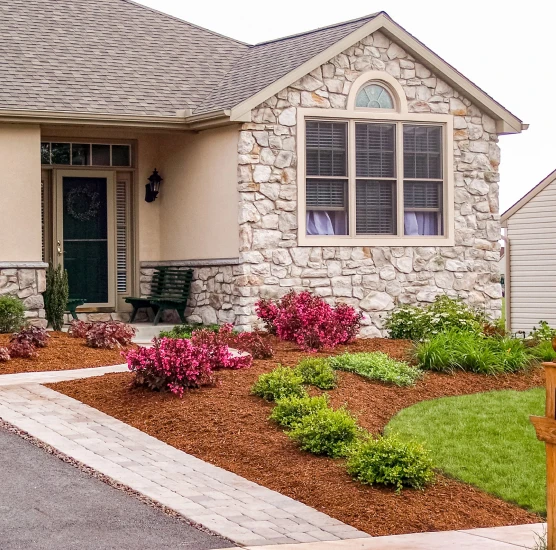Understanding landscape and hardscape, also called softscaping, is essential to creating an outdoor area with improved aesthetics and functionality and enhancing home value.
Landscaping refers to living in your backyard, such as flowers and trees; hardscaping is all non-living elements, such as walls and pergolas. Both are important and complement each other. For example, retaining walls control drainage and keep plants healthy while adding visual interest and structural support.
Knowing the difference between landscape and hardscape also aids in cost-savings and better decisions regarding environmental impact.
This article offers a perspective on hardscape VS landscape consideration in modern landscape projects.
What is Hardscaping?
To hardscape means to combine non-living elements, such as patios, decks, and stone features, to add structure, functionality, and design to outdoor space.
- Hardscaping Elements
Hardscaping allows you to transform a plain area into a unique space and to blend art with architectural elements such as:
- Patios and decks – Man-made areas designed for outdoor living and dining; suitable for indoor-outdoor transition and entertainment, relaxation, or work
- Walkways and pathways: Functional paths made from natural stones, concrete, or pavers can also be an artistic experience for the hardscape expert as a visual journey through the garden.
- Retaining walls – Decorative and functional structures that hold the soil back and define garden zones, suitable for terraced gardens and seated walls
- Fences and trellises – Architectural elements installed for privacy, aesthetics, or supporting the plant’s vertical growth
- Parking areas and driveways – Concrete or asphalt purposely built areas for cars
- Water features – Artificial waterfalls, fountains, and ponds add sound, movement, and tranquility to a landscape
- Hardscaping Materials
Another difference between landscaping and hardscaping is the material selection and aspects to consider. Hardscaping materials need to bear support because of the nature of hardscaping vs. landscaping. Landscaping materials support plant growth and focus on plant hardiness. Hardscaping materials need to be weather-resistant and functional.
Since hardscaping materials must withstand different weather conditions, aid the appearance, and support the landscape, they are essential for every outdoor project. Most people focus on concrete, brick, and natural stones, such as limestone, granite, and sandstone, for larger areas and use metal to add accent or wood to build decks and fences.
- The Purpose of Hardscaping
Hardscaping serves several purposes as part of the landscape design and functionality:
- To add structural shape
- To extend the usable space, add privacy or security, and reduce maintenance
- To define edges and divide outdoor areas into functional zones
- To improve accessibility
- To help with the drainage or create microclimates for plants
- To provide the foundation for other hardscaping or landscaping elements
- To enhance visual interest and complement landscape features
- To ensure year-round functionality and aesthetic of the outdoor space, regardless of weather conditions
What is Landscaping (Softscaping)?
Landscaping is about living and growing outdoor space elements, which change through seasons and bring life to your garden through planting. Landscaping evolves and brings dynamic, natural beauty to your space, such as spring blooming colors through dramatic fall foliage. Softscaping is plants and the soil in which they live and develop.
- Softscape Elements
Consider the following softscape elements for your outdoor area:
- Lawns and turf: Grassy open spaces are suitable for different purposes, including playing and relaxing; they improve the overall backyard aesthetic and require regular maintenance to stay lush, healthy, and pulled together.
- Trees, Shrubs, and Plants: Natural elements of every garden used with different intentions in landscaping; trees ensure shade and structure, while shrubs contribute to privacy and are excellent for filling space; plants, alongside trees and shrubs, are natural habitats for wildlife and improve the overall look
- Flower Beds and Gardens: Dedicated zones in the garden with flowers, fruits, or veggies.; they add color, texture, and seasonal interest and produce fresh food for homeowners; these zones require maintenance but are the most rewarding
- Ground Cover: These are low-growth plants chosen for their capabilities in erosion prevention; they can create lush ground layers, cover bare areas, and have a similar effect as mulch; most popular are ivy or moss types.
- Materials and Purpose
Softscaping focuses on keeping the plants healthy and thriving with soil types, mulch, compost, and different plant species as materials.
When it comes to the purpose between landscape vs hardscape, it is easy to anticipate. Living softscaping elements highlight natural beauty, enhance air quality, and attract wildlife. That way, landscape elements create a cohesive area with various aspects of flora and fauna. In addition, large trees provide shade and improve functionality.
Key Differences Between Hardscaping and Landscaping
If you are just about to start your first hardscape project, recognize what is the difference between hardscape and landscape to combine elements well. Hardscapes are permanent and non-living structures, while landscape design combines living plants.
Every other difference between hardscape and landscape comes from that.
- Longevity and Maintenance:
Hardscapes are long-lasting and require minimal upkeep. For instance, you may need to reseal concrete or clean the rusty patina from the metal retaining wall.
Landscape elements need:
- Seasonal planting
- Pruning
- Fertilizing
- Mowing
- Pest control
- Impact on Drainage and Water Management
Concrete and pavers are impervious, meaning they don’t absorb water, so they can increase water runoff. Such scenarios can lead to flooding or water accumulation. A potential solution is adding a gravel base layer and installing permeable pavers instead of traditional concrete.
On the other hand, landscaping elements, such as ground covers, absorb excess water and aid in stormwater management.
- Functionality:
Hardscaping improves functionality and terrain, while landscaping improves aesthetics and biodiversity.
In addition, landscape elements have more critical environmental benefits. Plants absorb carbon dioxide, and large trees store carbon over time. Natural plants are habitats for insects and birds, so they contribute to a balanced ecosystem and sustain local wildlife.
In urban areas, landscape elements are crucial for reducing temperatures and providing oxygen. Landscaping enhances aesthetics and environmental benefits, providing shade, natural beauty, and biodiversity.
Combining Hardscape and Landscape for a Cohesive Design 250
Instead of thinking about landscaping vs hardscaping as one or the other, think about the cohesiveness of their elements. For example, a garden hardscape with plants, a retaining wall, and a dedicated area for seating under tall trees result in a harmonious and functional outdoor space.
Here are practical tips for a balanced combination of hardscape and landscape:
- Make your pathway more naturally-looking with pavers and ground cover edging.
- Build raised garden beds or stone planters to connect the hardscape and landscape elements naturally.
- Focus on the balance between hardscape and landscape elements.
- Integrate landscape and hardscape with gradual changes, for example, stepping stones leading into garden beds or plants around stone walls.
- Keep everything in scale – Build hardscape elements in the size that matches landscape elements; otherwise, they may overpower and create disproportional space.
- Mix hardscape and landscape items for focal points; for example, water fountains surrounded with colorful flowers or koi ponds are excellent combinations.
- Pick complementing colors and textures of hardscape and landscape to avoid abrupt contracts and keep visual continuity.
Conclusion
A harmonious and functional outdoor space combines hardscaping elements and landscaping living items. Pergolas, patios, decks, and walls are some examples of common hardscaping elements made from bricks, concrete, and wood.
Landscaping elements are plants and soil, large trees, and flowers, adding seasonal interest instead of hardscape elements that look good year-round.
Sometimes, combining the two requires skills and experience to ensure harmony in your backyard. If you feel overwhelmed with the functional features of hardscaping work and trees and shrubs, consult a professional landscaping company.
Integrity Land Woks can develop a functional and beautiful unique combination of hardscape and landscape tailored to your needs and available space.
FAQ
What are the most famous landscape trends?
Popular landscaping trends focus on low-maintenance landscapes achieved through native plants and xeriscaping. In addition, expanding living spaces with outdoor hardscaping features and sustainable designs are significant trends in landscaping. Lastly, edible gardens with fruits and veggies are becoming more popular among urban gardeners.
What are the maintenance requirements for hardscape vs. landscape?
Hardscape elements require sealing or fixing cracked stones or bricks. On the other hand, landscapes need regular maintenance year-round. You can also hire specialized companies to maintain regular landscapes.
How to balance massive hardscape features with delicate plants in my garden?
Balance large and heavy hardscaping features with plants by focusing on gradual transition. For example, cascading plants can be put along massive walls or medium-sized shrubs can be used to transition between large patios and lawns.
What is the difference between landscaping and hardscaping in installation?
Landscaping is often less labor intensive than hardscaping but requires specialized knowledge about soil, plant types, care, and sessional requirements.
Hardscaping requires precision cutting, heavy lifting, leveling, and construction skills.

